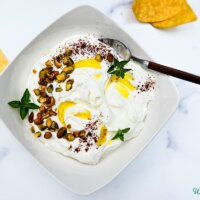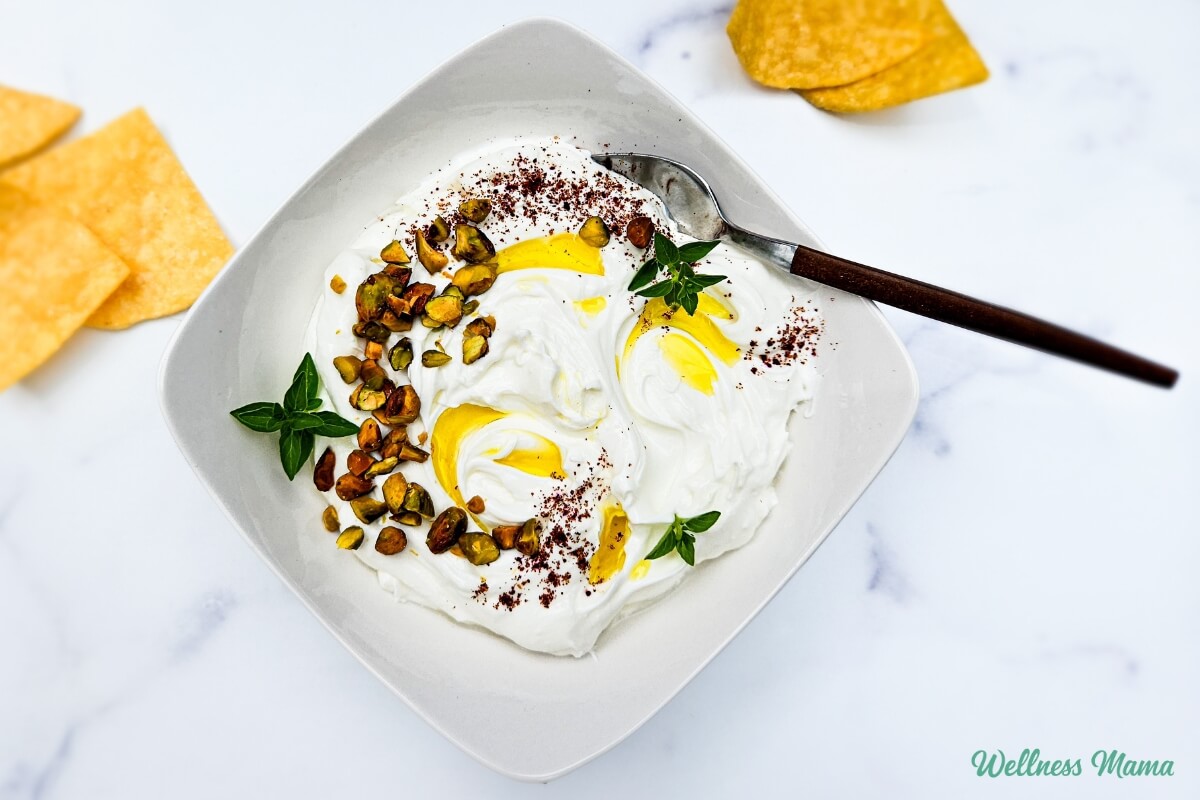I’m always looking for more ways to use the fresh herbs growing in my garden. This homemade labneh recipe is a great way to do that. It’s a creamy, rich yogurt dip that’s the perfect accompaniment to fresh veggies or your favorite chips.
What is Labneh?
This traditional yoghurt is a staple food for those in the Arabic and Middle Eastern regions. People will eat it for breakfast, lunch, supper, or as an appetizer. Its popularity has spread in recent decades so you’ll find it in kitchens and restaurants around the world. Labneh is made by straining the whey out of whole milk yogurt and adding seasonings to taste.
Traditional Labneh toppings include sumac (staghorn sumac) and za’atar spice, a blend of Meditteranean herbs. Straining the yogurt not only concentrates the flavor but it ups the protein in this soft cheese. Then there are the probiotics and healthy fats.
The Best Yogurt for Labneh Cheese
There are several options, but basically, any full-fat animal milk yogurt will work. You can use plain yogurt, goat milk yogurt, or Greek yogurt. Greek yogurt is already partially strained, so it won’t yield as much liquid. Be sure to avoid anything low-fat or with added sugar and flavors. I often make homemade yogurt from grass-fed cows to avoid the junk in many store-bought brands.
How to Strain Homemade Labneh
Straining labneh is simple enough, but there are a few tricks. First, choose a bowl that’s deep or large enough. You don’t want the yogurt sitting in its own whey or it won’t strain. You’ll also need a mesh strainer to prop on top of your bowl.
Most of the yogurt will drain out if you only use a strainer, so it’s important to also line the strainer. Muslin or cotton cheesecloth works well for this, but some people also use paper towels. I prefer cheesecloth because it’s more sustainable and reusable.
If you don’t have a metal strainer just use a cheesecloth. Lay the cheesecloth across the top of your bowl and put the yogurt in the center. Next, gather up the corners and tie them around the handle of a wooden spoon. The wooden spoon rests across the top of the bowl, suspending the yogurt and cheesecloth above the bottom.
Labneh needs to be strained for a minimum of 12 hours but it’s best to wait a day (or more). The longer it strains the thicker it gets. You don’t want to leave it in the fridge for too long though or it will dry out completely.
When you’re done straining the labneh, don’t throw the liquid away! The strained whey is great to use for probiotic-rich lacto-fermented salsa or veggies.
How to Eat Your Homemade Labneh
There’s really not a bad way to eat labneh. The creamy yogurt base is versatile so you can make it sweet or savory and serve it with a variety of things. Try lemon zest, lemon juice, and a hearty drizzle of honey for a fruit dip. Or keep it traditional with sumac powder, za’atar, and extra virgin olive oil. Everything bagel seasoning with roasted red peppers is another yummy option.
Most people use labneh for pita chips and bagels. Since we don’t do a lot of grains at our house you’ll usually find us dipping veggies in it. You can also try some homemade almond flour crackers or cassava chips. And if you make a sweet version it makes a great fruit dip.
You can also use labneh to replace sour cream or cream cheese in your recipes for a protein boost. In the Middle East, they’ll often include labneh as part of a mezze platter. These platters consist of small dishes of appetizers, snacks, and finger foods to make a meal. They’re like healthy Lunchables for adults.
Finish it With Salt
I also like to add a sprinkle of finishing salt to the top. Our family uses naturally harvested salt like Himalayan salt and Celtic sea salt for most things. For this dip though I used Maldon sea salt. Maldon salt is hand-harvested sea salt from the southeast coast of England.
This unique salt forms a pyramid structure or flakes that add a unique crunch and saltiness to foods. You can’t find it anywhere else in the world and the same family has been harvesting it for over 135 years. People have used salt from that particular region though for several thousand years!
If you don’t want to use Maldon salt then try topping your labneh with a sprinkle of your salt of choice. Even with sweeter dips, it adds a nice contrast.

Mediterranean Labneh Recipe
Servings
Ingredients
- 2 cups whole milk yogurt (or Greek yogurt)
- ½ tsp Maldon salt
Optional Toppings and Mix-Ins
- 2 tsp Sumac powder (or lemon zest)
- 1 tsp Za’atar spice
- ¼ tsp Garlic powder
- ¼ cup Pistachios (chopped)
- 2 TBSP Fresh herbs (such as dill, mint, oregano, and basil)
Instructions
- In a medium bowl, stir together the yogurt and salt.
- Line a mesh strainer with several layers of cheesecloth and scoop the yogurt into the cheesecloth.
- Suspend the strainer over a large bowl or a deep bowl, leaving enough space under the strainer for the whey to drip out.
- Place the bowl in the refrigerator for 24 hours and allow the yogurt to drain.
- Lift the cheesecloth out of the strainer and dump the strained yogurt into a bowl.
- Add desired toppings or mix-ins and enjoy as a dip.
Nutrition
Notes
Have you ever tried labneh before? What are your favorite ways to eat it? Leave a comment and share below!


Leave a Reply